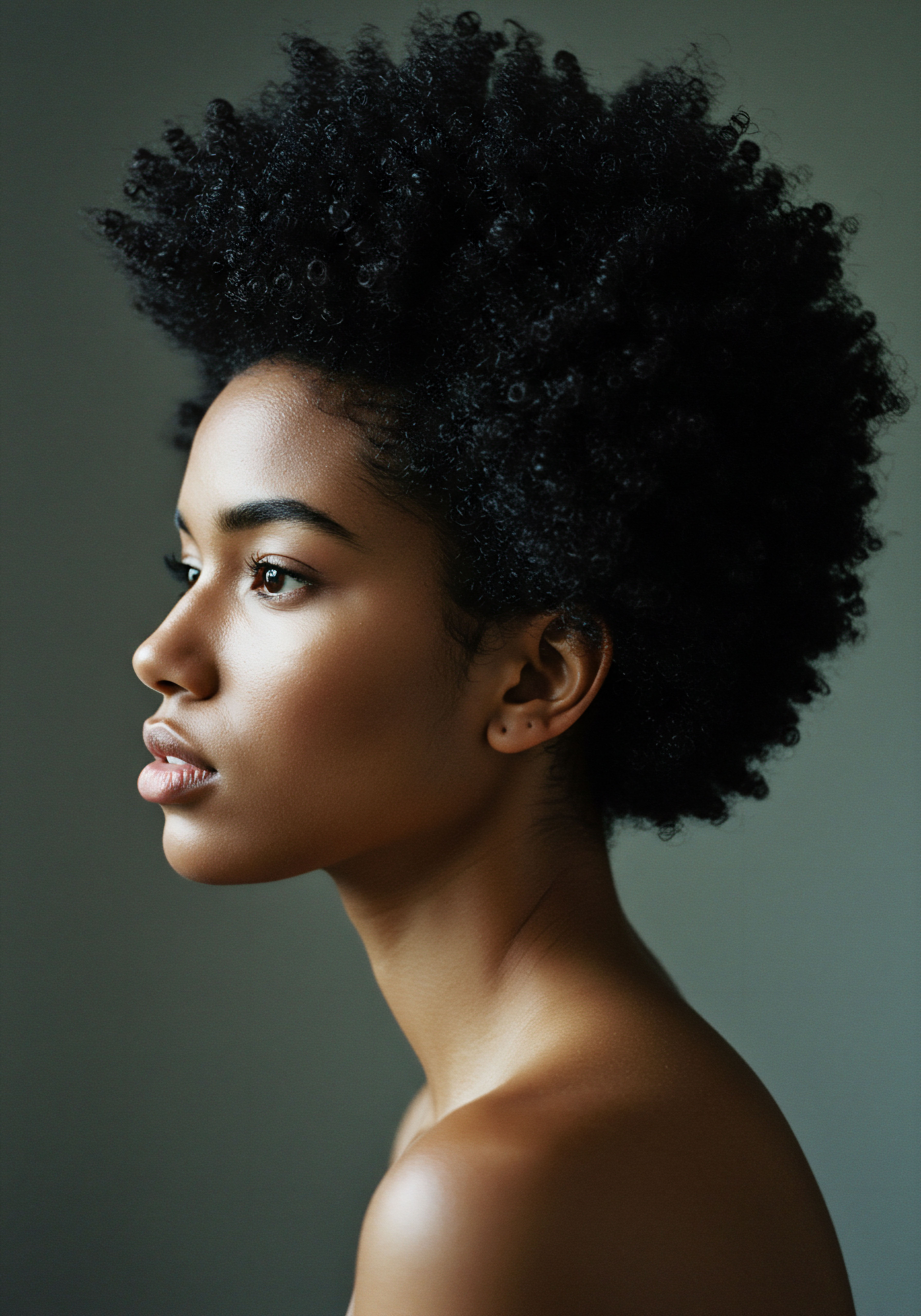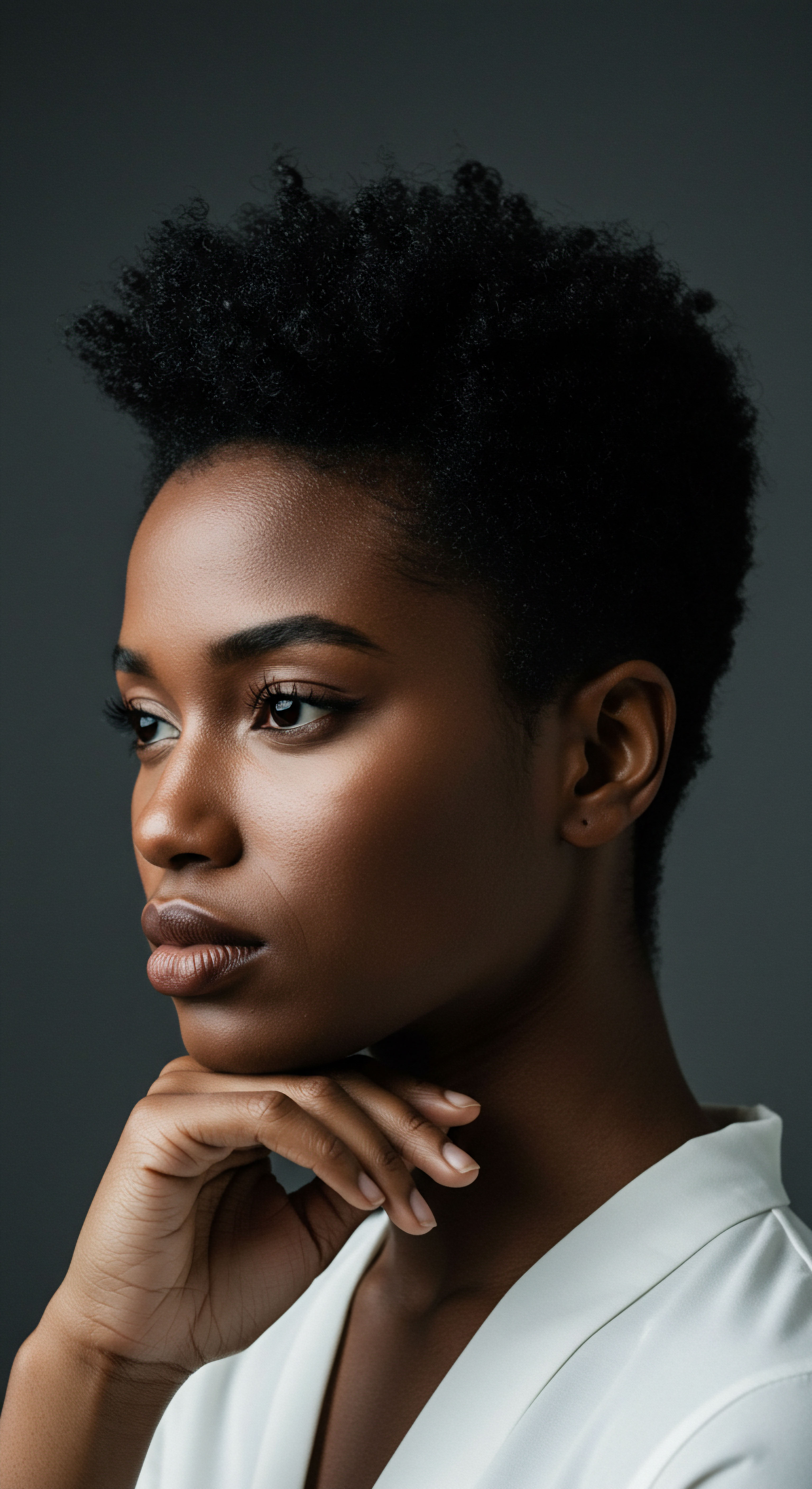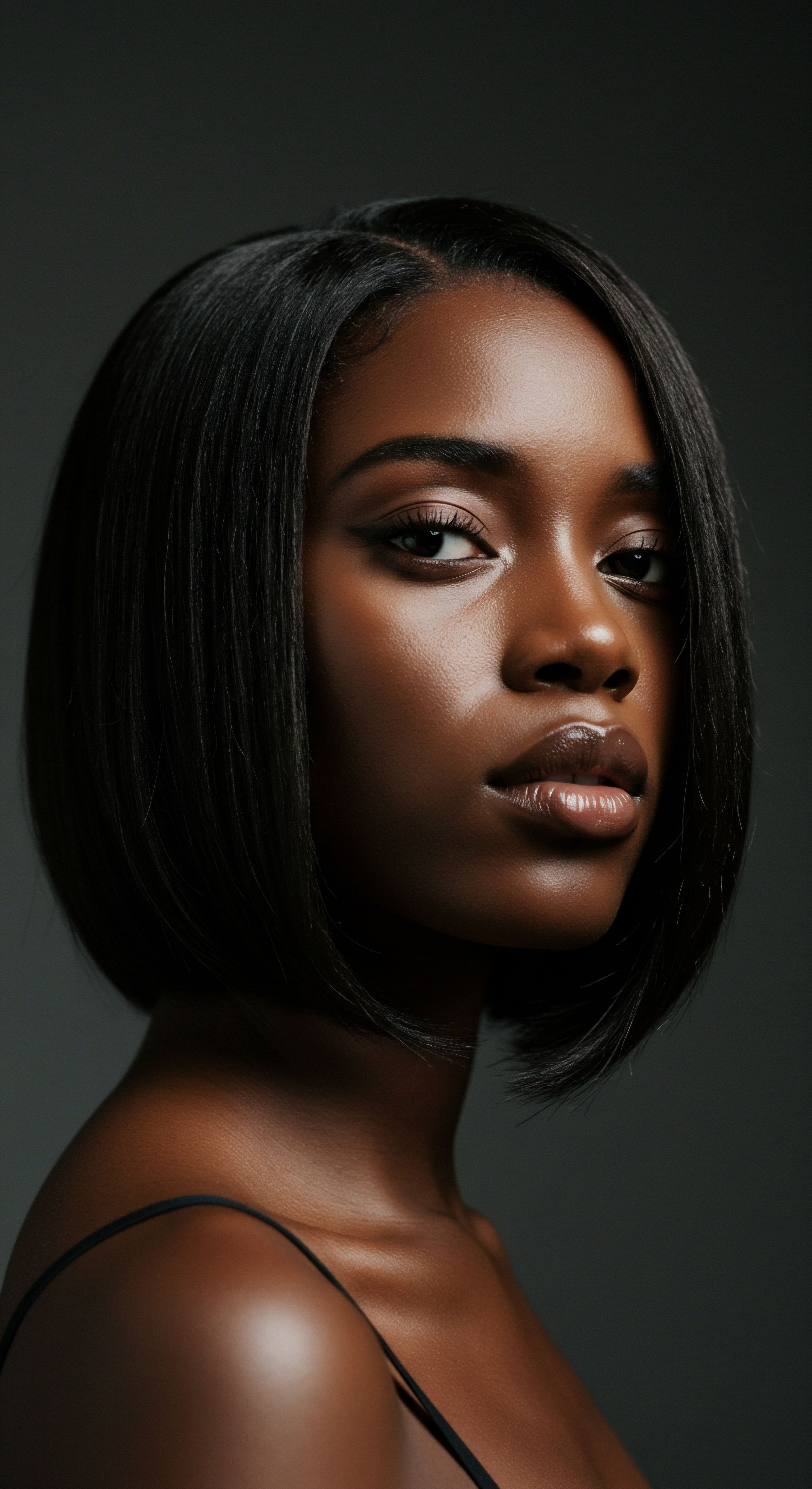
Roots
The quiet rhythm of our days and nights holds a profound, often unacknowledged, influence over the delicate dance of our hair. We often ponder the lotions and potions, the combs and conditioners, yet the most fundamental aspects of our being—the very ebb and flow of our existence—whisper secrets to our strands. Consider for a moment the gentle cadence of sleep, not merely as a respite for the mind, but as a deep, restorative process for every cell, including those tirelessly working within our scalp. The timing of this slumber, its consistent embrace or its fragmented refusal, speaks directly to the core mechanisms that govern hair’s vitality.
Hair growth, far from a simple, continuous act, unfolds within a precisely orchestrated biological cycle. This cycle, an intricate ballet of cellular division and rest, is deeply entwined with our body’s internal timekeepers. Understanding this foundational connection begins with a closer look at the hair follicle itself—a miniature organ nestled beneath the skin, a bustling hub of activity.
Each follicle operates on its own timeline, cycling through phases of active growth, transition, and rest. This biological clockwork is surprisingly susceptible to external cues, none more pervasive than the pattern of our sleep.
Hair growth is an intricately timed biological cycle, deeply influenced by the body’s internal rhythms and the consistent pattern of sleep.

Hair Anatomy and Physiology Specific to Textured Hair
The architecture of textured hair, with its unique bends and coils, presents a distinct set of physiological considerations. Unlike straight strands that emerge from a round follicle, coily and kinky hair typically originates from an Elliptical or Flat Follicle Opening. This shape dictates the hair shaft’s helical growth, creating points of vulnerability at each curve.
The cuticle layers, which serve as the hair’s protective outer shield, may lift more readily at these bends, increasing susceptibility to moisture loss and mechanical damage. The growth process within these uniquely shaped follicles, therefore, demands an even more robust and harmonious internal environment to thrive.
The hair follicle, regardless of hair type, contains a dermal papilla at its base, a cluster of specialized cells that receive nourishment from blood vessels and communicate with surrounding matrix cells. These matrix cells are responsible for rapid cell division, forming the hair shaft. Surrounding the dermal papilla are Hair Follicle Stem Cells, quiescent powerhouses waiting for the signal to activate and regenerate the follicle during each new growth cycle.
The health and precise timing of these stem cells are paramount for consistent, robust hair production. Any disruption to the body’s systemic rhythms, including those governed by sleep, can send discordant signals to these delicate cellular communities, potentially impacting their regenerative capacity.

Hair Growth Cycles and Influencing Factors
The hair growth cycle is a fascinating, multi-stage process:
- Anagen ❉ The active growth phase, where hair cells rapidly divide, pushing the hair shaft outwards. This phase can last for several years, determining the maximum length a hair can reach. For textured hair, this phase can sometimes be shorter compared to straight hair, contributing to perceived slower growth rates.
- Catagen ❉ A brief transitional phase, lasting a few weeks, where hair growth ceases and the follicle shrinks. The lower part of the follicle regresses, preparing for the next stage.
- Telogen ❉ The resting phase, where the hair remains in the follicle but is no longer growing. This phase can last for several months. At the end of telogen, the old hair sheds, and a new anagen phase begins, pushing out the old hair.
Beyond the inherent genetic programming of these cycles, numerous factors exert their influence. Nutritional status, hormonal balance, stress levels, and systemic health conditions all play significant roles. Yet, often overlooked is the profound impact of our internal biological clock, the Circadian Rhythm, which governs nearly every physiological process, including cell division and repair. Sleep timing is a direct reflection of how well we honor this intrinsic rhythm.
When our sleep patterns become erratic, misaligned with the natural day-night cycle, it can send confusing signals throughout the body, potentially disrupting the precise timing required for optimal hair follicle function and robust growth. The synchronization of these internal clocks with external light-dark cues is a silent conductor for the hair growth symphony.

Ritual
Stepping from the foundational understanding of hair’s internal workings, we now turn our gaze to the daily and nightly practices that shape its vitality. The wisdom of our ancestors, passed down through generations, often centered on routines that honored the body’s natural inclinations. For textured hair, the nightly ritual holds a particularly potent power, a time when intentional care can fortify strands against the rigors of the day and prepare them for the restorative processes of sleep. The delicate balance of our hair, its inherent thirst for moisture and its vulnerability to friction, finds solace in the quiet hours of slumber, provided we set the stage with mindful preparation.
Our sleep patterns, particularly their regularity, are not just a matter of convenience; they are a profound conversation with our biology. The body, a creature of habit, yearns for predictability. When sleep arrives at consistent intervals, it allows the intricate repair and regenerative processes to unfold without interruption.
This includes the subtle yet continuous work happening within our hair follicles. The nightly application of gentle moisture, the careful wrapping of strands, and the choice of sleep surfaces become more than mere habits; they transform into a protective ritual, a quiet affirmation of hair wellness that complements the body’s nocturnal restorative efforts.

The Nighttime Sanctuary Essential Sleep Protection
The hours spent in slumber offer a unique opportunity for hair rejuvenation, but also pose potential challenges. Unprotected hair, particularly textured strands prone to tangling and breakage, can suffer considerable mechanical stress against abrasive pillowcases. The friction generated can lead to lifted cuticles, split ends, and breakage, negating daytime care efforts. Establishing a dedicated nighttime sanctuary for your hair means creating an environment that minimizes these stressors.
Key elements of this protective ritual include:
- Satin or Silk Pillowcases ❉ These materials offer a smooth, low-friction surface, allowing hair to glide rather than snag. This drastically reduces mechanical damage and helps retain moisture, which is especially critical for thirsty textured hair.
- Protective Styles ❉ Before bed, consider gently gathering hair into loose braids, twists, or a pineapple bun. These styles keep strands contained, minimizing tangling and friction against bedding, while also preserving curl patterns.
- Moisture Sealing ❉ A light application of a leave-in conditioner or a botanical oil before styling can help seal in moisture, keeping strands supple and less prone to breakage throughout the night.

Bonnet Wisdom for Textured Hair
The humble bonnet, a staple in textured hair care, is far more than a simple accessory; it is a guardian of strands, a symbol of intentional care. Its soft, often satin or silk lining, creates a micro-environment around the hair, preserving moisture and preventing the hair shaft from rubbing against cotton bedding, which can wick away essential hydration.
Choosing the right bonnet involves considering material, fit, and comfort. A well-fitting bonnet should be snug enough to stay on throughout the night but not so tight as to cause tension around the hairline. The benefits extend beyond mere physical protection:
- Moisture Retention ❉ The smooth lining helps keep the hair’s natural oils and applied products on the strands, rather than absorbing into the pillowcase. This is vital for preventing dryness, a common concern for textured hair.
- Frizz Reduction ❉ By minimizing friction, bonnets significantly reduce frizz and preserve defined curl patterns, leading to less manipulation needed in the morning.
- Breakage Prevention ❉ The protective barrier of a bonnet shields delicate strands from snagging, pulling, and breakage that can occur during restless sleep.
A consistent nighttime hair ritual, especially using satin protection and mindful styling, fortifies textured strands against sleep-related friction and moisture loss.
The deliberate practice of these nighttime rituals aligns with the body’s need for restorative periods. When sleep timing is consistent, the body’s repair systems are more efficient. By providing a protective external environment for our hair during these crucial hours, we create a synergistic effect, allowing the internal regenerative processes to work their magic on strands that are already safeguarded and nourished. This gentle, consistent care becomes a quiet conversation with our hair, a testament to its value.

Relay
What deeper currents flow beneath the surface of our sleep and hair growth? The relationship extends far beyond the visible realm of external care, delving into the intricate cellular choreography governed by our internal clocks. This is where the science of chronobiology intersects with the delicate biology of the hair follicle, unveiling a complex interplay that challenges our conventional understanding. It prompts us to consider not just the quantity of sleep, but its precise alignment with the natural world, and how this synchronicity, or lack thereof, ripples through our very being, touching even the growth of our strands.
The human body operates on a remarkable schedule, a symphony conducted by the suprachiasmatic nucleus (SCN) in the brain, our master clock. This SCN, responsive to light and darkness, orchestrates the release of hormones and regulates countless physiological processes, setting the tempo for our daily rhythms. Yet, what if the hair follicle itself possesses a similar, localized timekeeping mechanism, a cellular drumbeat independent yet influenced by the grand orchestral movements of the body? This concept, while perhaps less commonly discussed, offers a profound perspective on how sleep timing, as a powerful environmental cue, can directly influence hair’s vitality.

Does Hair Possess Its Own Internal Clock?
The idea that individual organs and tissues harbor their own circadian clocks, synchronized by the master SCN but capable of independent rhythmicity, is a captivating area of research. For hair, this suggests that the cells within the follicle—from the dermal papilla to the matrix cells—might possess a molecular apparatus that anticipates and responds to daily cycles. This intrinsic timing mechanism could dictate optimal periods for cell division, protein synthesis, and even the hair’s transition between growth phases.
Consider the work of Plonka et al. (2005), who investigated the expression of Circadian Clock Genes in human hair follicles. Their research demonstrated that key clock genes, such as CLOCK, BMAL1, PER1, and CRY1, are indeed expressed in human hair follicles and exhibit rhythmic oscillations over a 24-hour period. This suggests that the hair follicle is not merely a passive recipient of systemic signals but possesses an autonomous, genetically programmed temporal organization.
This means the follicle itself has a built-in schedule for its activities. When our overall sleep timing is consistent, it reinforces and harmonizes with this inherent follicular rhythm. Conversely, chronic disruption to sleep patterns could send conflicting signals, potentially desynchronizing the hair follicle’s internal clock from the body’s master clock, leading to less efficient growth and repair processes.

The Hormonal Tide and Follicular Response
Sleep timing profoundly impacts the delicate balance of hormones that influence hair growth. Growth hormone, for instance, is predominantly released during deep sleep. This hormone plays a role in cellular regeneration and protein synthesis, both vital for hair production. Erratic sleep schedules can diminish the secretion of growth hormone, potentially slowing down the cellular activity within the hair follicle.
Cortisol, often termed the “stress hormone,” follows a distinct circadian rhythm, peaking in the morning and gradually declining throughout the day, reaching its lowest point during early sleep. Chronic sleep deprivation or irregular sleep timing disrupts this natural pattern, leading to elevated cortisol levels. Prolonged high cortisol can push hair follicles prematurely into the resting (telogen) phase, leading to increased shedding. This phenomenon, known as Telogen Effluvium, is a common consequence of significant physiological stress, including that induced by persistent sleep disturbances.
| Hormone Growth Hormone |
| Sleep Timing Impact Optimal release during deep, consistent sleep. Reduced with fragmented or late sleep. |
| Hair Growth Relevance Promotes cell division and protein synthesis vital for hair shaft formation. |
| Hormone Cortisol |
| Sleep Timing Impact Natural circadian rhythm, lowest during consistent sleep. Elevated with sleep disruption. |
| Hair Growth Relevance High levels can trigger premature telogen phase, leading to increased shedding. |
| Hormone Melatonin |
| Sleep Timing Impact Naturally produced in darkness, signaling sleep. Topical application shows hair growth benefits. |
| Hair Growth Relevance Directly stimulates hair follicle anagen phase and acts as an antioxidant. |
| Hormone The body's nocturnal hormonal shifts are intricately tied to hair follicle health and growth cycle progression. |

Beyond the Individual Hair Cycle
The cultural and social implications of sleep timing also merit consideration, particularly within communities that have historically faced disproportionate stressors. The demands of multiple jobs, non-standard work hours, or societal pressures can often force individuals into sleep patterns that deviate significantly from natural circadian rhythms. This isn’t merely a personal choice; it’s often a systemic reality.
The chronic stress and physiological toll of such sleep fragmentation can manifest in various ways, including compromised hair health. For textured hair, already susceptible to unique challenges, this added layer of systemic stress can exacerbate issues like dryness, breakage, and thinning.
The hair follicle itself possesses an intrinsic circadian clock, making consistent sleep timing a powerful synchronizer for optimal hair growth.
Understanding the profound biological and socio-cultural dimensions of sleep timing allows for a more comprehensive approach to hair wellness. It moves beyond superficial remedies, encouraging a deeper respect for the body’s inherent wisdom and the conditions it requires to thrive. The consistency of our sleep, therefore, is not just about feeling rested; it is a silent, powerful contributor to the very structure and strength of our hair, a profound relay of information from our internal world to our outward appearance.

Reflection
The quiet revolution of understanding our hair truly begins when we recognize its profound connection to the deepest rhythms of our being. The conversation surrounding sleep timing and hair growth invites us to pause, to listen to the subtle whispers of our body’s innate wisdom. It reveals that the vibrant health of our textured strands is not merely a product of external applications, but a radiant expression of internal harmony, a delicate balance struck within the sanctuary of consistent slumber. This journey of understanding reminds us that genuine hair wellness is a holistic pursuit, one that honors the intricate dance between science, ancestral knowledge, and the profound, restorative power of a well-timed rest.

References
- Plonka, P. M. Handerek, M. & Pielka, E. (2005). Expression of circadian clock genes in human hair follicles. Journal of Investigative Dermatology, 124(4), 857-860.
- Fischer, T. W. Burmeister, G. Schmidt, N. Kempf, W. Bielfeldt, S. & Hänggi, D. (2012). Melatonin increases anagen hair growth in human hair follicles in vitro. Journal of Pineal Research, 53(1), 32-38.
- Oh, S. M. Kim, S. J. Park, M. S. & Kim, H. S. (2018). Sleep deprivation-induced oxidative stress and hair loss. Journal of Cosmetic Science, 69(3), 193-201.
- Choi, S. S. Kim, H. R. & Kim, J. Y. (2020). The role of sleep in hair regeneration ❉ A systematic review. International Journal of Molecular Sciences, 21(18), 6667.
- Hardman, J. G. & Limbird, L. E. (Eds.). (2001). Goodman & Gilman’s The Pharmacological Basis of Therapeutics (10th ed.). McGraw-Hill. (General reference for hormonal regulation)
- Randall, V. A. (2008). Hormonal regulation of hair growth ❉ an overview. Growth Hormone & IGF Research, 18(2), 89-94.